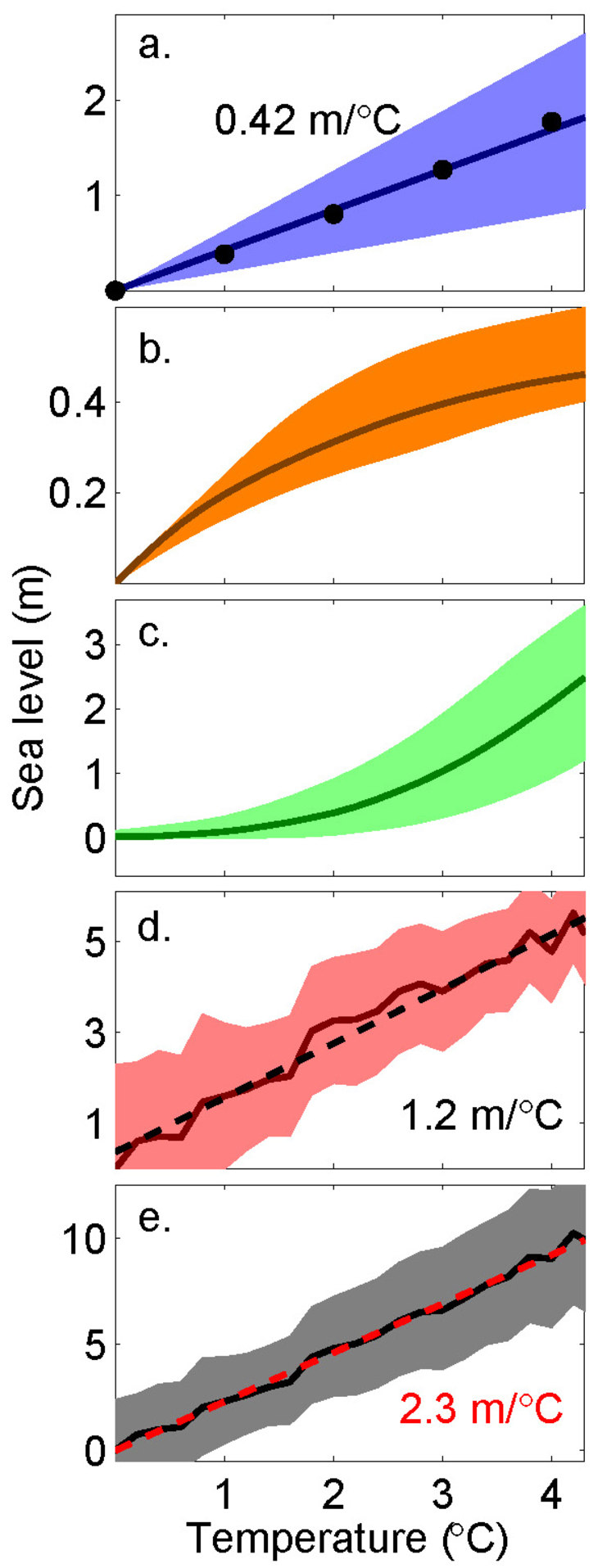Guest post by Anders Levermann [via The Conversation]
Small numbers can imply big things. Global sea level rose by a little less than 0.2 metres during the 20th century – mainly in response to the 0.8 °C of warming humans have caused through greenhouse gas emissions. That might not look like something to worry about. But there is no doubt that for the next century, sea level will continue to rise substantially. The multi-billion-dollar question is: by how much?
The upper limit of two metres that is currently available in the scientific literature would be extremely difficult and costly to adapt to for many coastal regions. But the sea level will not stop rising at the end of the 21st century. Historical climate records show that sea levels have been higher whenever Earth’s climate was warmer – and not by a couple of centimetres, but by several metres. This inevitability is due to the inertia in the ocean and ice masses on the planet. There are two major reasons for the perpetual response of sea level to human perturbations.
One is due to the long lifetime and warming effect of carbon dioxide in the atmosphere. Once emitted carbon dioxide causes warming in the atmosphere over many centuries which can only be reduced significantly by actively taking the greenhouse gas out again. This is because both the amount of heat and carbon dioxide the ocean can absorb is reduced, and so the temperature stays up for centuries or even millennia. Of course, not cutting emissions would exacerbate the problem even further.
The other reason is that both the ocean and the ice masses are very big and a warming of the surrounding atmosphere will only penetrate slowly, but inevitably, into them. As a consequence their sea level contribution continues even if the warming does not increase. Sea level rise over the last century has been dominated by ocean warming and loss of glaciers. Our recent study indicates that the future sea level rise will be dominated by ice loss from the two major ice sheets on Greenland and Antarctica – slumbering giants that we’re about to wake.

Graph: Sea level rise contributions over 2000 years from: ocean warming (a), mountain glaciers (b), Greenland (c) and Antarctic (d) ice sheets. The total sea level commitment (e) is about 2.3m per degree of warming above pre-industrial.
It is easier to understand a future world that has adjusted to a new equilibrium of higher temperatures than it is to understand the dynamic (perhaps rapid) transition from today’s world to a warmer one. That is why we used physical models for the ocean, the mountain glaciers and the big ice sheets to compute how the systems would be different if the world was warmer.
What we found was that for each degree of global warming above pre-industrial levels the ocean warming will contribute about 0.4 metres to global mean sea-level rise while Antarctica will contribute about 1.2 metres. The mountain glaciers have a limited amount of water stored and thus their contribution levels off with higher temperatures. This is over-compensated for by the ice loss from Greenland, so that in total sea level rises quasi-linearly by about 2.3 metres for each degree of global warming (see figure).
How fast this will come about, we do not know. All we can say is that it will take no longer than 2,000 years. Thus the 2.3 metres per degree of warming are not for this century. They need to be considered as our sea level commitment – the sea level rise that cannot be avoided after we have elevated global temperatures to a certain level.
Ben Strauss of Climate Central has considered the different possible future pathways that society might take and computed which US cities are at risk in the long-term. He poses the question as to what year, if we continue with greenhouse emissions at current rates, we will have caused an inevitable sea level rise that puts certain cities at risk.
According to his analysis, within the next few years Miami in Florida will be committed to eventually lie below sea level, while our future actions can still decide on whether we want to one day give up cities such as Virginia Beach, Sacramento, Boston, Jacksonville or New York City.
This is a decision society has to take for future generations. We will need to adapt to climate change in any case, but some things we will not be able to adapt to. Society needs to decide whether we want to give up, for example, the Tower of London, or to put the breaks on climate change so that we don’t have to.
Weblink: The New York Times has a good current article on this issue.
Anders Levermann is department head at the Potsdam Institute for Climate Impact Research, Germany
Nenhum comentário:
Postar um comentário